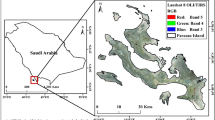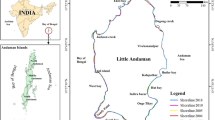Abstract
Sagar Island, situated in the east coast of India and one of the biggest deltas in Sundarban group, faces coastal erosion and degradation of coastal vegetation and various natural hazards. Erosion is mainly due to clay mining, wave activities, and the impact of river and tidal currents of Muri Ganga and Hugly Rivers. Further, the coastal zone of Sagar Island faces increasingly severe problems of rapidly growing human population, deteriorating environmental quality, and loss of critical habitats. Sagar Island has been victimized several times by tropical cyclones and influenced daily by tidal fluctuations. The island needs immediate attention on the coastal zone in order to protect the shoreline and ecosystem. The capability of satellite remote sensing to provide synoptic, repetitive, and multispectral data has proved to be very useful in the inventory and monitoring of critical coastal issues. Sagar Island and its environs are subjected to both natural and anthropogenic activities that continuously modify the region.
Similar content being viewed by others
References
Baksi, A., Hazra, S., Sen, G., & Mukherjee, A. D. (2001). Estimation of relative sea level rise from Tide Gauge data of Sagar island of Bay of Bengal. Journal of Coastal Research.
Bandopadhyay, S. (2000). Sagardwip: Some environmental problems and men. In B. Maity (Ed.), Bish Sataker Sagardwip (20th Century Sagar Island) Quarterly April–June.
Das, G. (2000). History of Sagardwip: 1815–1915. In B. Maity (Ed.), Bish Sataker Sagardwip (20th Century Sagar Island) Quarterly April–June.
Dinesh Kumar, P. K., Gopinath, G., Laluraj, C. M., Seralathan, P., & Mitra, D. (2007). Change detection studies of Sagar island, West Bengal (India) using IRS IC LISS III DATA. Journal of Coastal Research, 23(6), 1498–1502. doi:10.2112/05-0599.1.
Gopinath, G., & Seralathan, P. (2005). Rapid coastal erosion of the Sagar Island, West Bengal. Environmental Geology, 48(8), 1058–1067.
Krishnamoorthy, R. (1995). Remote sensing of mangrove forest in Tamil Nadu coast, India (202 p.). Ph.D. thesis, Anna University.
Mukherjee, K. N. (1983). History of settlement in the Sundarbans. Indian Journal of Landscape Systems and Ecological Studies, 6, 1–19.
Nayak, S. R. (2002). Application of remote sensing to coastal zone management in India. Paper presented in ISPRS Technical Commission VII Symposium on Remote Sensing and Environment Monitoring and ISRS Annual Convention held at Hyderabad, India.
Thanikachalam, M., & Ramachandran, S. (2002). Conservation of coral reefs in Gulf of Mannar: A remote sensing and GIS approach. Indian Society of Geomatics (ISG) Newsletter, Special Issue on Coastal & Marine Environment, 8(2 & 3), 65–71.
Thanikachalam, M., & Ramachandran, S. (2003). Shoreline changes along the coast of Gulf of Mannar and its influence on coral reefs: A remote sensing and GIS approach. Journal of the Indian Society of Remote Sensing, 31(3), 157–174.
Author information
Authors and Affiliations
Corresponding author
Rights and permissions
About this article
Cite this article
Gopinath, G. Critical coastal issues of Sagar Island, east coast of India. Environ Monit Assess 160, 555–561 (2010). https://doi.org/10.1007/s10661-008-0718-3
Received:
Accepted:
Published:
Issue Date:
DOI: https://doi.org/10.1007/s10661-008-0718-3




